Description and Requirements
The Book
Bibliography
Syllabus
 Introduction
Introduction The Great Pyramid
The Great Pyramid Music of the Spheres
Music of the Spheres  Number Symbolism
Number Symbolism  Polygons and Tilings
Polygons and Tilings  The Platonic Solids
The Platonic Solids  Roman Architecture
Roman Architecture  Number Symbolism in the Middle Ages
Number Symbolism in the Middle Ages  The Wheel of Fortune
The Wheel of Fortune  Celestial Themes in Art
Celestial Themes in Art  Origins of Perspective
Origins of Perspective  What Shape Frame?
What Shape Frame?  Piero della Francesca
Piero della Francesca  Leonardo
Leonardo  Façade measurement by Trigonometry
Façade measurement by Trigonometry  Early Twentieth Century Art
Early Twentieth Century Art  Dynamic symmetry & The Spiral
Dynamic symmetry & The Spiral  The Geometric Art of M.C. Escher
The Geometric Art of M.C. Escher  Later Twentieth Century Geometry Art
Later Twentieth Century Geometry Art  Art and the Computer
Art and the Computer  Chaos & Fractals
Chaos & Fractals
BRUNELLESCHI'S PEEPSHOW
&
THE ORIGINS OF PERSPECTIVE
"Perspective is the rein and rudder of painting"
Leonardo da Vinci
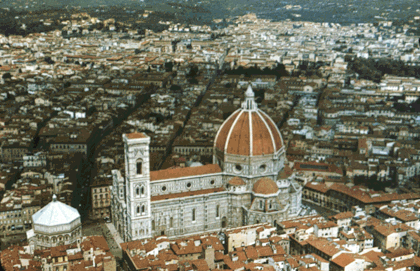
Slide 12-5: Aerial View of Santa Maria della Fiore, the Duomo, and the Bapistry.
Edizioni Becocci-Firenze
We move now into the early Renaissance, with a survey of linear perspective.
The entire theory of perspective can be developed from a single fact: that the apparent size of an object decreases with increasing distance from the eye. That's the phenomenon that makes railroad tracks appear to converge in the distance.
We will start with explanations of what perspective is, and then outline its historical development, from Brunelleschi's experiment to Alberti's Treatise, in the early Renaissance, followed by early examples of the use of perspective. We will then quickly survey what has happened to perspective up to the present time.
| Outline: | What is perspective? |
| Brunelleschi's Peepshow | |
| Donatello | |
| Masaccio | |
| Mantegna | |
| Alberti | |
| From Euclid to Desargues | |
| What Next? | |
| Summary |
Pictures before Perspective
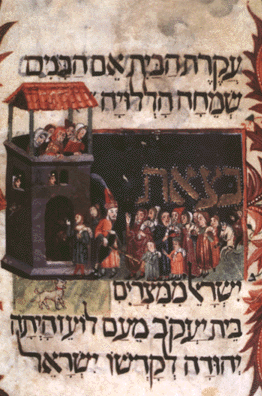 |
Slide 12-1: Inital word panel of
Psalm from the Kaufmann Haggadah. Spain, late 14th C. Keller, Sharon. The Jews: A Treasury of Art and Literature. NY: Levin Assoc. 1992. |
These perspectival errors appear in paintings usually done before 1400.
The perspective lines usually converge, but not to a single point and not on the horizon.
Pictures after Perspective
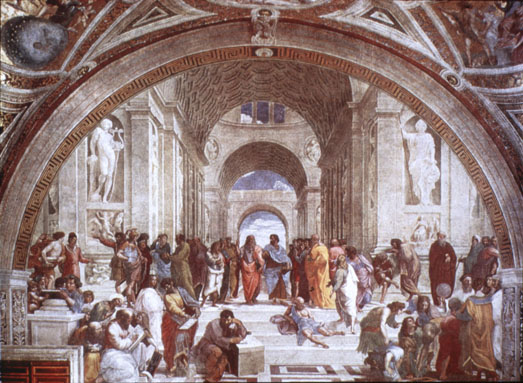
Slide 3-1: RAPHAEL: School of Athens American Catalog, p. 126, #21061
Shows one-point (linear perspective)
Brunelleschi's Peepshow
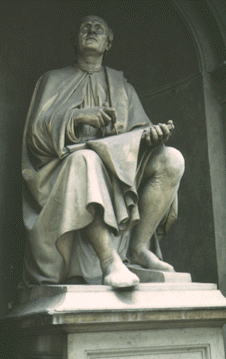 |
Slide 12-4: BRUNELLESCHI: Statue of Brunelleschi Calter Photo |
So what happened? Why did pictures change from those without perspective to those that had perspective? For one thing, Brunelleschi happened!
Filippo Di Ser Brunellesco (1377-1446), sculptor, architect, and artisan-engineer, is given credit for the invention of linear perspective. Here he is looking up at the famous dome he built for the Duomo (1418-1436) in Florence. He also built San Lorenzo and many other structures.
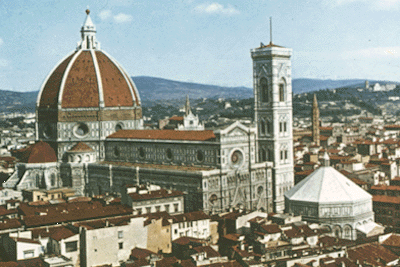 |
Slide 12-6: Cathedral
Firenze, N-26 |
The Peepshow
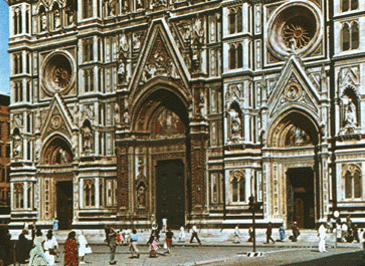 |
Slide 12-10: The Duomo and Piazza del Duomo
FIRENZE, N-23 |
Imagine that it is sometime during the early 15th century, between 1410 and 1420, in this Piazza Duomo in Florence. You see Brunelleschi standing in the west door of the unfinished cathedral. He beckons eagerly to you and has you face the Baptistery across the piazza. This the same Baptistery we saw pictures of when we discussed the octogon.
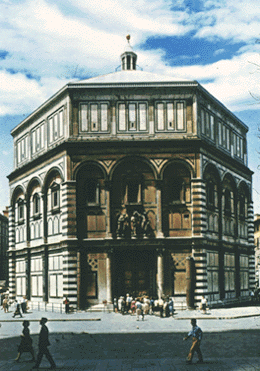 |
Slide 12-11: The Bapistry, San Giovanni
FIRENZE, N-20 |
He holds up a picture of the Baptistery painted on a panel, its back towards you, and has you squint through a small hole in the painting.
According to Brunelleschi's biographer Antonio Manetti, Brunelleschi "had made a hole in the panel . . . which was as small as a lentil on the painting side . . . and on the back it opened pyramidally, like a woman's straw hat, to the size of a ducat or a little more."
Through the hole you saw a mirror which reflected the painting itself so you see the front of the painting in the mirror. Then Pippio whisks away the mirror so that you see the real Baptistery through the peephole and you are amazed because they are so similar.
But this was no ordinary painting. It is said to have been the first accurate perspective picture.
No written record exists from Brunelleschi's experiments. He probably passed the method verbally to Masaccio, Masolino, and Donatello, who used it in their works.
Project: Reproduce the Peepshow demonstration.
Donatello
The earliest surviving use of linear perspective in art is attributed to Donato di Niccolò di Betto Bardi (1386-1466), called Donatello, who is considered by many to be the greatest sculptor of the early Renaissance in Italy, and perhaps one of the greatest sculptors of all time.
St. George and the Dragon
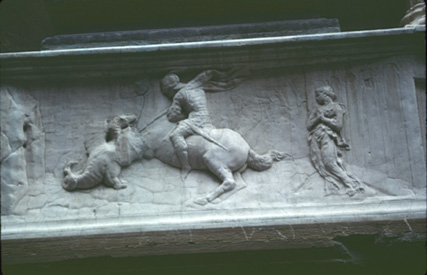 |
Slide 12-12: DONATELLO: Relief: St. George and the Dragon
Calter Photo |
Donatello later did some marble statues for the facade of the cathedral in Florence, and two for Orsanmichele, his St. Mark and his St. George (c. 1412). The latter is particularly interesting to us. Below the main sculpture-in-the round of Saint George is a marble relief showing him slaying the dragon.
In this panel, sometimes called a rilievo schiacciato (ski-a-chat-o) or flattened relief,
Donatello appears to be using linear perspective. However the orthogonals are not so clearly defined that one can say for certain that he is using perspective, or to let us locate a precise vanishing point.
The Feast of Herod
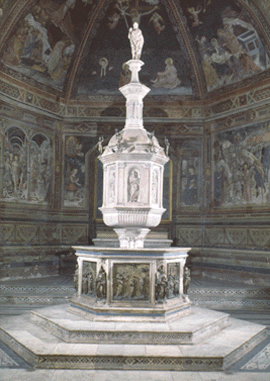 |
Slide 12-13: Bapistry Font, Siena
© Scala/ Firenze, 1990 |
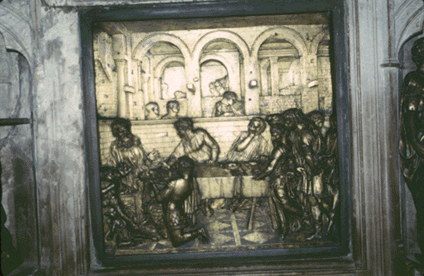 |
Slide 12-14: DONATELLO: Feast of Herod,
c. 1425
Calter Photo |
There is no lack of certainty, however, about Donatello's use of perspective in his bronze Feast of Herod. This panel, made for the font of the Siena cathedral, (which we saw before when discussing the octogon) is widely recognized as the first relief sculpture to use linear perspective.
The orthogonals are not very long or prominent, but what there is of them can be seen to intersect at a vanishing point near the elbow of the musician in the central window. The vanishing point would be at eye level for the figures seated behind the table, if they were sitting up straight.
It has been pointed out that Donatello's use of linear perspective is imperfect here, because the orthogonals do not quite meet in a single vanishing point, but this imperfection is small and may have occurred in the chasing of the bronze, and not in the original design.
At any rate, it is a far more advanced perspective construction than in his St. George relief. It is no longer empirical, but is apparently based on theory.
Masaccio
Masaccio (1401-c.1428) is considered by many to be one of the triumvirate, along with Brunelleschi and Donatello, who laid the foundations for the Renaissance in Italy. Masaccio's first known painting, the triptych Madonna and Child with Saints (c.1422) shows no sign of linear perspective. However, three other paintings, all done in the last four years of his short life, do show perspective, and are the works on which Masaccio's fame rests.
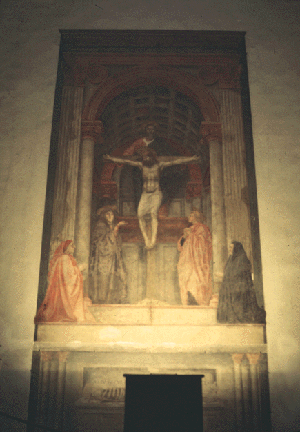 |
Slide 12-16: MASACCIO:Trinity
Calter Photo |
Of the three, Masaccio's Trinity, painted for S. Maria Novella in Florence around 1427, is usually considered to be the oldest surviving perspective painting. It is considered his most mature work.
We see a pyramid of figures topped by God, who holds the cross. The holy spirit is represented by the dove. St. John the Baptist on the right and the Madonna is on the left. The Madonna looks directly at us and presents Christ to us. The figures frame Christ, in the center.
Massacio is said to have consulted with Brunelleschi on this painting. He used a grid framework, tooled right into the surface, and very rigorous linear perspective. Even the nails are shown in perspective! He placed the vanishing point at the Mound of Golgotha, or Cavalry, the place outside Jerusalem's walls where Jesus was crucified, at the eye level of an average person. He probably felt that the illusion of depth would be greatest with the viewer right on the centric ray.
Perspective used to provide narrative focus:
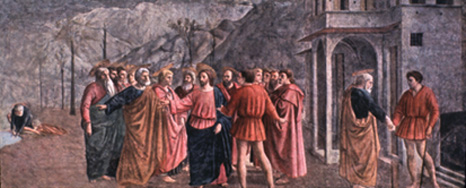
|
| Slide 12-18: MASACCIO: Tribute Money,
Janson, H.W. History of Art. Fifth Edition. NY: Abrams, 1995. |
So we see that in addition to spatial organization and illusion of depth and a structural focus, perspective can provide narrative focus. Since the eye invariably travels to the vanishing point of a picture, Renaissance artists did not hesitate to put something important at or near that point. Masaccio's use of perspective is clearest in his frescos for the Brancacci Chapel in S. Maria del Carmine in Florence, which illustrate scenes from the lives of St. Peter and St. Paul. In particular, his Tribute Money (c. 1425) shows the confrontation of temporal and spiritual authority, and shows clear and effective use of perspective.
Perspective not only provides a visual structure for the painting, but a narrative focus, by having the vanishing point at Christ's head.
Project: Xerox a few paintings. Draw orthogonals and locate VP. Speculate as to why the artist placed it there.
Mantegna
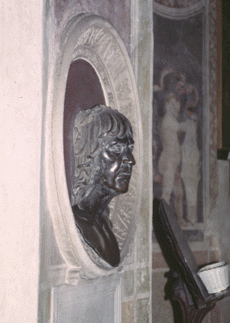 |
Slide 12-19: MANTEGNA: Bust of Mantegna
in Sant' Andrea, Mantua
Calter Photo |
The artist-scholar Andrea Mantegna (active 1441, d.1506) used linear perspective with dramatic effect. Here we mention only his fresco cycle, largely destroyed by allied bombing during WWII, in the Ovetari Chapel of the Church of the Eremitani in Padua (1455), which depict scenes from the life of St. James.
Ovetari Chapel frescos
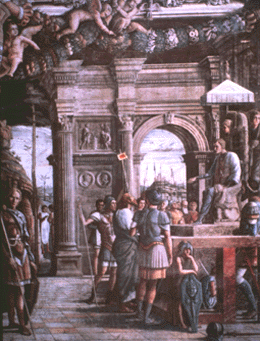
|
Slide 12-20: MANTEGNA: St. James before Herod
Agrippa,c. 1455
American Library Color Slides Co. Inc., Cat. #23354 |
The pavement in his St. James before Herod Agrippa is laid out in a strict grid, divided into cubits. The vanishing point in this painting is located in the frame between this painting and the one immediately to its left, and is shared by that painting.
The two lowest scenes in the cycle are made extremely dramatic by having a vanishing point below the bottom frame of the paintings. This placement may have been due to Donatello's influence.
Alberti
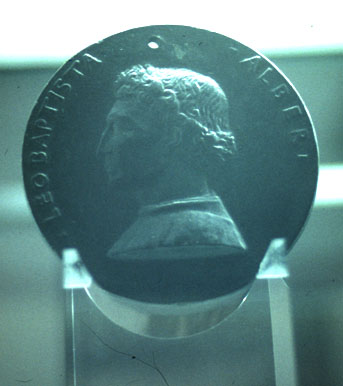 |
Slide 17-02 : ALBERTI: Medal recto
Cole,p. 12 or Reti, p. 219 |
Leon Battista Alberti (1404-1474) was, according to the Encyclopedia of the Italian Renaissance,
"humanist scholar, natural scientist, mathematician, cryptographer, pioneer of the Italian vernacular, author." He was also a noted architect who built Sant' Andrea, were we just saw the bust of Mantegna, Santa Maria Novella in Florence, in which Masaccio's Trinity is painted, and many others.
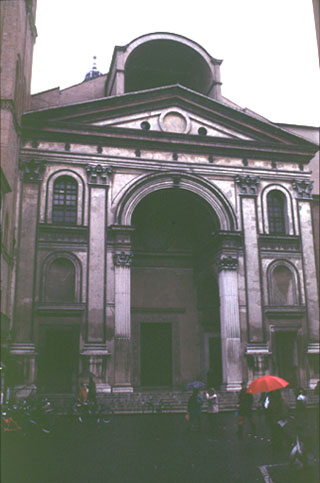 |
Slide 17-03 : Sant' Andrea, Mantua
citation |
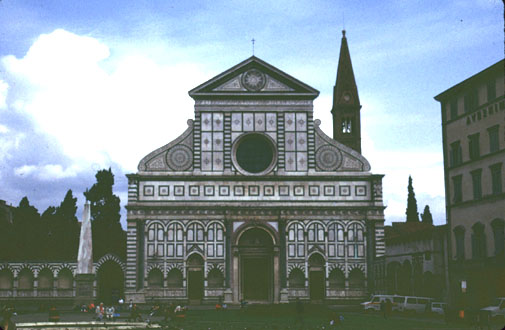
He is said to have invented the camera obscura. Any camera, including the camera obscura, automatically makes perspective pictures. Thus if Alberti did indeed invent the camera, or was even familiar with the device, it is hard to imagine that this did not influence his development of perspective theory.
Project: Make a camera obscura
Della pittura
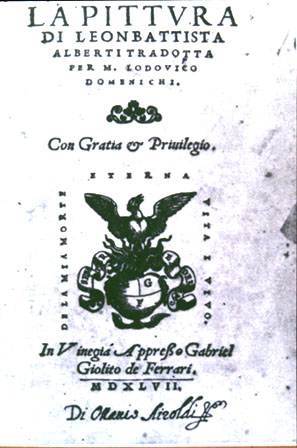 |
Slide 17-05: Cover of Della Pittura
citation |
As Brunelleschi made no written record of his perspective findings, it remained for Alberti to be the first to put the theory into writing, in his treatise on painting, Della pittura (1435). There, Alberti gave practical information for painters and advice on how to paint istoria or history paintings. We will discuss only the section which gives the first written account of linear perspective.
The Velo
Alberti described how an artist could get a correct view of a scene by observing it through a thin veil, or velo. The idea is that we can get a correct image of some object seen through such a veil or a window by tracing the outline of the object on the window glass. Albrech Durer designed several such machines.
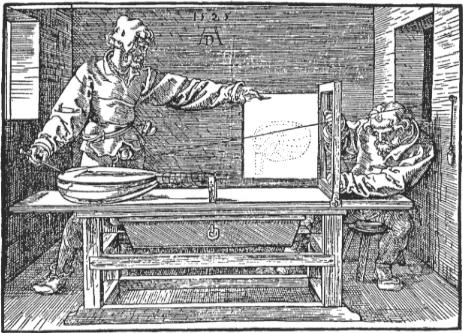
One of Durer's Perspective Machines
Kurth, Plate 338
Project: Make a perspective machine. Use it to make a perspective picture.
The Costruzione Legittima
Alberti gives the following method for constructing a picture of a horizontal grid, like the paving stones in a plaza, which has come to be called an Albertian Grid. In his description he has the orthogonals and transversals both spaced by one braccio, a Florentine unit of measure equal to 1/3 the height of a person, about 23 inches. His construction is called the Costruzione Legittima.
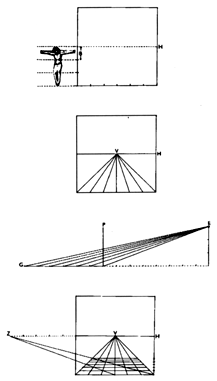
|
Alberti's Construction
1.B-one braccio module (one third of the height of a man).
The base of the picture is divided into braccia.
The height of the man at the front plane of the picture gives the
level of the horizon, H. 2. The braccio divisions are joined to the perspective focus, V, to give the orthogonals. 3. In side elevation, lines are drawn from braccio divisions behind the picture plane P to the eye at E. The points of intersection on P are noted. 4.The levels of the points of intersection are marked at the side of the picture plane, and locate the horizontal divisions of the tiles. Z is the 'distance' point, though Alberti only mentions using one diagonal to check the construction. Kemp, p. 23 |
Project: Draw a pavement before being shown any perspective construction. Then draw a pavement after being shown the method. Compare the two.
Project: Reproduce Alberti's Costruzione legittima.
From Euclid to Desargues
Roots
Like most discoveries, perspective theory did not emerge out of a vacuum. The underlying ideas had been accumulating for centuries. While the main application of perspective is in art, it is an optical phenomenon and thus has its principal root not in art but in geometrical optics.
Euclid's Optica, C. 300 B.C., was the first text on geometrical optics, in which are defined the terms visual ray and visual cone.
Vitruvius' Ten Books on Architecture which appeared about 25 B.C., was the only book on architecture to survive from antiquity. It profoundly influenced Renaissance architecture and thinking, including that of Alberti, who quoted Vitruvius in his Della pittura. Vitruvius wrote,
Perspective is the method of sketching a front with the sides withdrawing into the background, the lines all meeting in the center of a circle. Unfortunately he didn't elaborate on that. Elsehere, Vitruvius' reference to Greek and Roman stage design, implied an understanding of the vanishing point.
Ptolemy's Optica, c. 140 A.D., was another early text on geometrical optics, and included theories on refraction. The centric ray is defined by Ptolemy as the ray that does not get refracted. The centric ray, we'll see, is important in the theory of perspective. In his Geographia, c. 140 A.D., Ptolemy applies the principles of geometric optics to the projection of the spherical surface of the earth onto a flat surface, to produce a map. He is said to have made the first known linear perspective construction for drawing a map of the world. Ptolemy apparently knew about perspective, but applied it only to maps and to stage designs.
Galen's De usu partium, c. 175 A.D., contains an early but erroneous description of how the eye creates images. The book was still important, however, as a stepping stone in the development of the theory of perspective.
From Islam, Alhazen's Perspectiva, c. 1000 A.D., was an important compendium on optics. It integrated the works of Euclid, Ptolemy, and Galen.
Roger Bacon's Opus Majus, c. 1260 A.D., included a section on optics, whose geometric laws, he maintained, reflected God's manner of spreading His grace throughout the universe.
John Pecham's Perspectiva communis, c. 1270 A.D., was another treatise on optics that was widely available during the Renaissance. Finally, Blasius of Parma's Quaestiones perspectivae, c. 1390 A.D., was a popular adaptation of the works of Bacon and Pecham.
Commerce in Florence
Another element that set the stage for the development of perspective was the rise of banking and commerce in thirteenth century Florence, accompanied with widespread knowledge of arithmetic, especially the figuring of proportions, with geometry to allow a merchant to gauge volumes of wine casks and piles of grain, and of simple surveying for the division of land.
What does bookkeeping have to do with art? It is probable that the tidy mathematical ledgers of the Florentine merchants, made them more receptive to the tidy mathematical organization of space afforded by linear perspective, and the geometric constructions of perspective resonated with the familiar geometric constructions of surveying. While this did not directly contribute to the development of perspective, it did provide a receptive climate.
Mirrors
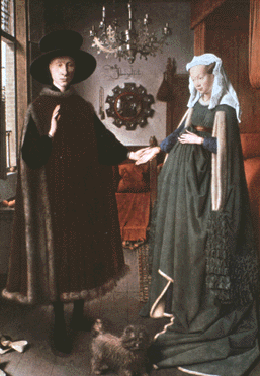 |
Slide 12-23: JAN VAN EYCK: Arnolfini Newlyweds,
or Wedding Portrait, 1434
American Library Color Slides Co. Inc., Cat. #893 |
Another contributing factor to the development of perspective was the current interest in mirrors. The flat, lead-backed mirror was introduced in the thirteenth century and apparently fascinated artists and writers as much as it did those interested in optics.
Dante made several references to mirrors. Giotto is said to have painted "with the aid of mirrors." Alberti recommends looking at a painting in a mirror to expose its weaknesses. In his Della pittura he writes "A good judge for you to know is the mirror. I do not know why painted things have so much grace in the mirror. It is marvelous how every weakness in a painting is so manifestly deformed in the mirror."
The mirror shown in the famous painting of the Arnolfini Newlyweds of Jan Van Eyck, was said to have been a standard piece of furniture in the studios of late medieval painters.
This increased use of mirrors by artists generated interest in geometrical optics and provided a way to see a real scene on a flat plane. The convergence of parallel lines to a vanishing point when seen in a real scene is easily ignored because it is so familiar. But when seen on the unfamiliar flat surface of a mirror is less likely to go unnoticed. This may have caused artists to look for the same phenomenon in the real world.
From Euclid to Desargues
Perspective is an example of the geometric operation of projection and section where projection lines from the outline of an object to the eye are sectioned or cut by a picture plane. This has roots in the conic sections, where projection lines from a circle to a point form a cone, which is then sectioned by a plane to give a circle, ellipse, parabola, or hyperbola, depending on the angle of the cutting plane. These ideas were expanded by Gerard Desargues (1593-1662). Architect, engineer into the branch of mathematics called projective geometry.
What Next?
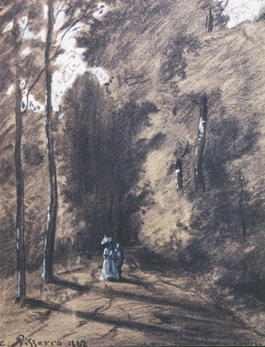 |
Slide 12-28: PISSARRO In the Wood, 1862
Sandak Slides, Inc |
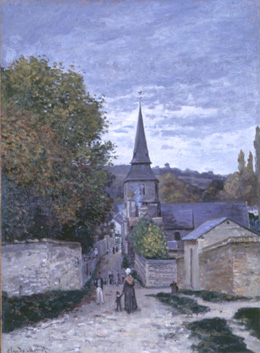
|
Slide 12-30: MONET:Street in Ste. Adresse, c. 1869
Sterling & Francine. |
We see from these pictures that perspective was alive and well right up to the end of the ninteenth century.
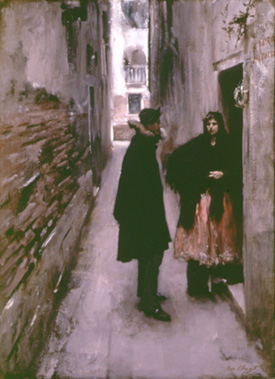
|
Slide 12-31: SARGENT:A Street in Venice, 1882
Sterling & Francine. |
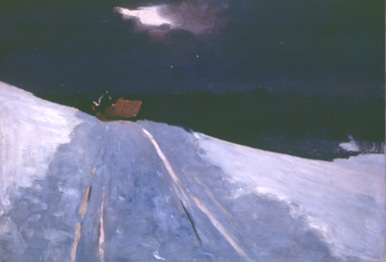
|
Slide 12-32: HOMER Sleigh Ride, 1893
Sterling & Francine. Clarke Art Institute, Williamstown MA. |
And then came the twentieth century, with cubists, futurists, constructivistsm Dadists, minimalists, and so on, who said, this is not a window! Stupid! Its a piece of canvas with paint on it. And along came the notion of integrity of the picture plane, and pictures got flat - so flat that art critics even argued over the thickness of the paint, and some artists thinned their oils with turpentine to eliminate even that thickness. And and perspective was dead, at least for the avante-guarde, although illustrators and other artists used it as before.
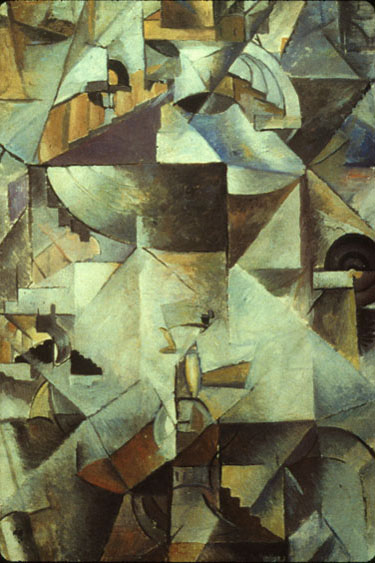 |
Slide: KASIMIR MALEVICH:Samovar
citation |
Summary
So we have seen the picture frame turned into a window frame and that linear perspective, so familiar now that we hardly notice it in a picture, had its roots in the developments in geometry, optics, and cartography, between the first and fifteenth century.
Then early in the 1400's the first known perspective picture was made by Brunelleschi, and perspective theory was described in writing by Alberti.
The perspective construction was then used by Donatello, Masaccio, Mantegna, and others, who produced a flood of perspective paintings and sculptures during the Renaissance. Their use of perspective was not only recognized and appreciated by their audiences.
We then saw examples of the use of perspective right up to the twentieth century when we'll later see the reasons for its decline.
Reading
Alberti's On Painting, pp. 43-59
Alison Cole, pp. 6-21
Kemp, The Science of Art, Chap. 1
Additional Bibliography:
Ivins, Edgerton, Pozzo, Dunning, Vredman de Vries, Rex Cole, Kubovy, Vasari on Brunelleschi, Donatello, Masaccio, Mantegna, Ucello,
Projects
- Reproduce the Peepshow demonstration.
- Xerox a few paintings. Draw orthogonals and locate VP. Speculate as to why the artist placed it there.
- Make a camera obscura.
- Make a perspective machine. Use it to make a perspective picture.
- Draw a pavement before being shown any perspective construction. Then draw a pavement after being shown the method. Compare the two.
- Reproduce Alberti's Costruzione legittima.
